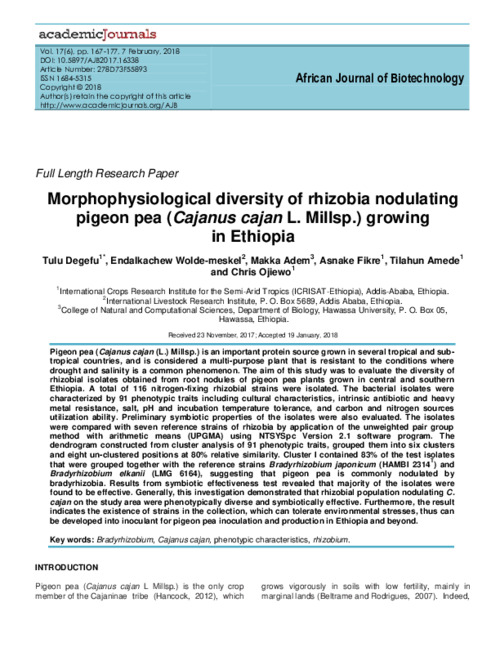Morphophysiological diversity of rhizobia nodulating pigeon pea (Cajanus cajan L. Mill) growing in Ethiopia
Abstract
Pigeon pea (Cajanus cajan (L.) Millsp.) is an important protein source grown in several tropical and subtropical
countries, and is considered a multi-purpose plant that is resistant to the conditions where
drought and salinity is a common phenomenon. The aim of this study was to evaluate the diversity of
rhizobial isolates obtained from root nodules of pigeon pea plants grown in central and southern
Ethiopia. A total of 116 nitrogen-fixing rhizobial strains were isolated. The bacterial isolates were
characterized by 91 phenotypic traits including cultural characteristics, intrinsic antibiotic and heavy
metal resistance, salt, pH and incubation temperature tolerance, and carbon and nitrogen sources
utilization ability. Preliminary symbiotic properties of the isolates were also evaluated. The isolates
were compared with seven reference strains of rhizobia by application of the unweighted pair group
method with arithmetic means (UPGMA) using NTSYSpc Version 2.1 software program. The
dendrogram constructed from cluster analysis of 91 phenotypic traits, grouped them into six clusters
and eight un-clustered positions at 80% relative similarity. Cluster I contained 83% of the test isolates
that were grouped together with the reference strains Bradyrhizobium japonicum (HAMBI 2314T) and
Bradyrhizobium elkanii (LMG 6164), suggesting that pigeon pea is commonly nodulated by
bradyrhizobia. Results from symbiotic effectiveness test revealed that majority of the isolates were
found to be effective. Generally, this investigation demonstrated that rhizobial population nodulating C.
cajan on the study area were phenotypically diverse and symbiotically effective. Furthermore, the result
indicates the existence of strains in the collection, which can tolerate environmental stresses, thus can
be developed into inoculant for pigeon pea inoculation and production in Ethiopia and beyond

